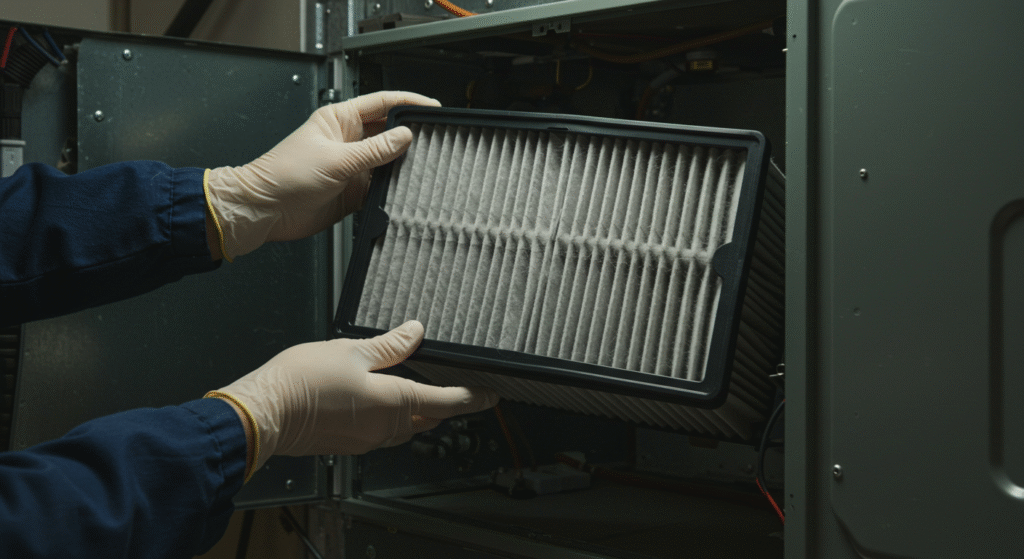At Shellaby AC & Refrigeration, we understand that your HVAC system is one of your most essential home comfort investments. A small lapse in filter care can lead to big headaches: poor airflow, higher energy bills, indoor dust, allergies, and early wear and tear on components. In this guide we’ll walk through everything you need to know from recognizing pain points, to step-by-step hvac air filter cleaning, to long-term strategies so your system runs smoothly and your indoor air stays clean.
Why HVAC Air Filter Care Matters (User Pain & Consequences) {#why-care}
When your HVAC air filter is neglected, here’s what typically happens:
- Reduced airflow means your blower has to work harder, which can shorten motor life or lead to fan failure.
- Dust and contaminants slip past or accumulate elsewhere, polluting indoor air and aggravating allergies or respiratory issues.
- Efficiency drops, which raises energy use and inflates utility bills.
- Over time, strain on coils and parts can lead to more frequent HVAC repair services or even premature replacement.
- In extreme cases, system freeze-up or overheating may occur.
Many homeowners wait until something fails. But being proactive with HVAC maintenance solutions is far more cost-effective than emergency calls or full HVAC system replacement near me. At Shellaby AC & Refrigeration, we emphasize preventive care to avoid those moments of regret.
Types of HVAC Air Filters & Which Ones to Clean vs Replace {#filter-types}
Not all filters are meant to be cleaned. Knowing your filter type helps you choose the right maintenance approach. Here are common filter types and best practices:
| Filter Type | Reusable or Disposable? | Cleaning Approach | Signs It Needs Replacement |
|---|---|---|---|
| Pleated fiberglass (standard) | Disposable | No cleaning—replace every 30–90 days | Tears, bending, heavy clogging |
| Washable / electrostatic | Reusable | Vacuum + rinse (never scrub harshly) | Loss of electrostatic function, holes |
| HEPA or high-MERV (if designed for reuse) | Sometimes reusable | Gentle rinse, air-dry fully | Warping, damage, reduced performance |
| UV/Media filters in air purifiers | Depends | Scope per manufacturer | If performance drops or media degrades |
For example, with electrostatic filters, you vacuum first, rinse carefully, and let them dry fully before reinstalling. Water or harsh detergents can damage them. In contrast, basic disposable filters don’t tolerate cleaning — trying to wash them can destroy the fibers and reduce filtration ability.
Knowing which type you have is key. When in doubt, check the filter frame or system manual, or ask a technician from your trusted local HVAC company near you for help.
Step-By-Step: How to Safely Clean Your HVAC Air Filter {#step-by-step}
Here’s a user-centered, easy-to-follow process (for reusable filters):
- Turn off the system at the thermostat and power box (breaker).
- Identify the filter location — often in the return vent, furnace air handler, or wall grill.
- Slide out or open the filter housing (note airflow arrow direction).
- Vacuum gently using a brush attachment on both sides.
- For deeper cleaning, rinse with lukewarm water from the clean side toward the dirty side to push particles outward. Avoid pressurized spray.
- If persistent grime remains, soak in a mild water + vinegar solution for 10–15 minutes, then rinse.
- Allow filter to air-dry fully — place it on a towel, flat, and flip midway. Never reinstall when damp.
- Inspect for damage (rips, warps). If compromised, replace instead of reinstalling.
- Reinsert correctly (align arrows), close housing, and restore power.
For filters that cannot be cleaned (disposable types), skip steps 4–7 — simply replace at recommended intervals. Attempting to clean disposable filters can void warranty and reduce filtration.
This approach reduces risk of damage, ensures clean operation, and avoids costly mistakes.
How Often Should You Clean or Replace Filter? {#frequency}

There’s no single answer, but here are some practical guidelines (adjust based on your home environment):
- Standard homes (no pets, mild dust): inspect every 1–2 months; clean or replace every 3 months.
- Homes with pets, allergies, or heavy dust: inspect monthly; clean or replace every 1–2 months.
- During heavy seasonal use (hot summer or cold winter): more frequent checks.
- Some reusable filters recommend cleaning 3–9 months depending on usage.
- If you see discoloration, increased dust, or feel worse air quality — act immediately.
The point is consistency. Create a schedule (e.g. mark calendar or set phone reminders) so filter care becomes routine. Many failures or repairs begin with a clogged filter — don’t let neglect lead to needing HVAC repair in Corpus Christi or furnace replacement Services in Port Aransas TX later.
What to Watch Out For: When Cleaning Isn’t Enough {#when-inspection}
There are times when cleaning or replacing the filter won’t resolve the issue. Signs include:
- Persistent low airflow even with a clean filter
- Strange noises or vibration in ductwork
- Uneven cooling or heating across rooms
- Frequent tripping of circuit or blower cutoff
- Sharp jumps in electricity bill
- Unusual odors from vents
In those cases, root problems might include:
- Duct leaks or blocked vents (consider duct cleaning and ventilation service)
- Malfunctioning blower motor
- Coil buildup and poor heat exchange
- Faulty thermostat or control board
- Undersized or failing HVAC units
When you detect these, it’s wise to call professionals. Shellaby AC & Refrigeration can conduct a full HVAC inspection and tune-up, diagnose root causes, and recommend repair or replacement.
Maintenance Tips & Best Practices (User-Focus) {#best-practices}
Here are practical tips to stay ahead of filter-related issues:
- Keep a log of filter changes or cleanings with date, filter type, and condition.
- Always have spare filters on hand for disposable types.
- Use filters with appropriate MERV ratings — too high a rating can choke older systems.
- Seal and insulate your ductwork to prevent infiltration of dust.
- Combine filter care with a seasonal HVAC tune-up.
- Consider indoor air quality upgrades (e.g. UV lamps, air purifiers) if allergies persist.
- In hot climates or dusty neighborhoods, inspect monthly.
- If you’re upgrading or installing a new unit, talk to residential HVAC installation or commercial HVAC contractors about designs that reduce airflow strain.
These habits help extend system life, reduce repair calls, and optimize indoor comfort.
When to Call Experts: Installation, Repair & Upgrades {#when-call}
If you notice warning signs beyond filter trouble, professional help is needed. Shellaby AC & Refrigeration, as a local HVAC company, can assist with:
- Full HVAC installation in Corpus Christi TX or air conditioning installation in Corpus Christi
- Emergency repairs and same-day service
- Upgrades to energy-efficient HVAC systems
- Heating services Corpus Christi or furnace replacement Corpus Christi
- Commercial projects, or transitions from old systems
- Indoor air quality testing, duct cleaning and ventilation service
- Seasonal inspection, HVAC tune-up near you
- Support for warranties, parts, and proper design
If you combine filter care with professional support, you minimize surprises and maximize system longevity.
Summary & Final Thoughts {#conclusion}
To recap: clean or replace filters regularly (based on type and environment), understand when cleaning isn’t enough, adopt best care practices, and enlist professional help when needed. Shellaby AC & Refrigeration values informed customers — you shouldn’t be guessing about your system’s health. We believe that combining smart DIY care with expert support is the ideal.
If you’re considering a new system or need quality Best HVAC Installat in Corpus Christi TX, check out our services at Shellaby AC & Refrigeration and learn more at our page for Best HVAC Installation in Corpus Christi TX.
Let this guide be your go-to for proper air filter care, ensuring healthier air, lower energy bills, and fewer HVAC surprises. (361) 386-2886






